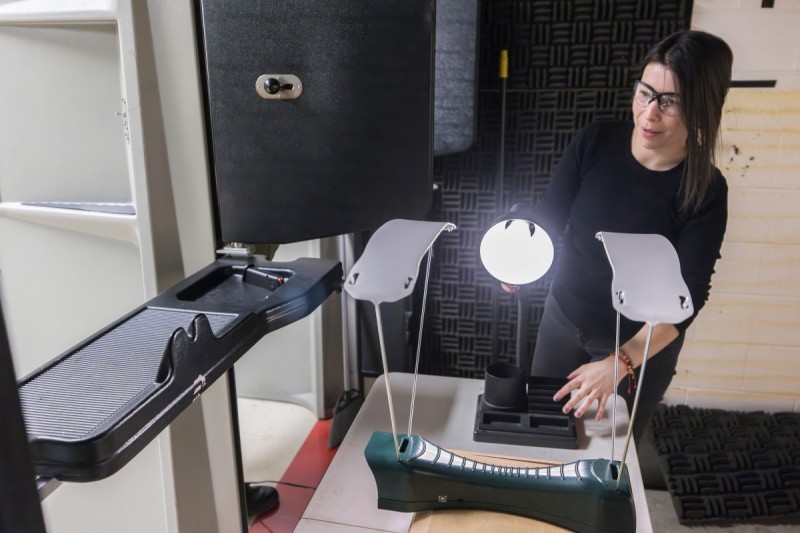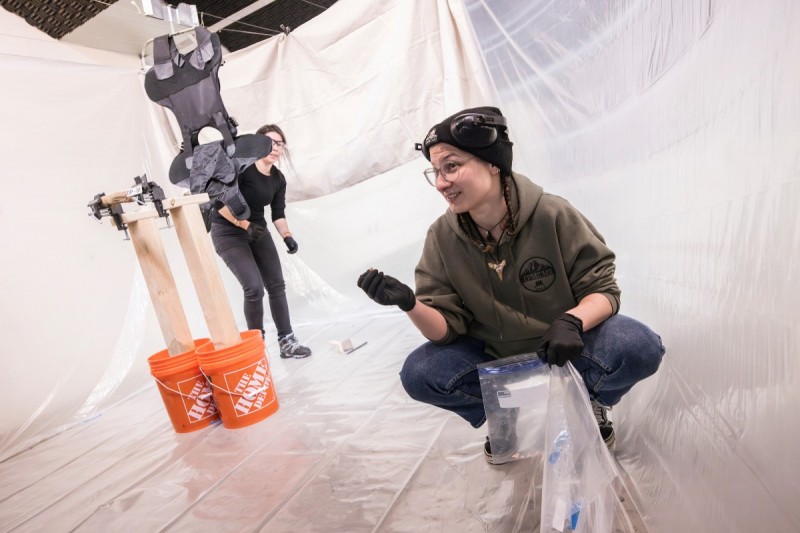Deposited in mass graves, silent bones can tell a story to those who know how to read them.
As a practicing forensic anthropologist in her native Colombia, that's something Binghamton University doctoral student Alexandra Semma Tamayo knows well. She has worked on cases involving that country's history of armed conflict, piecing together how an incident unfolded from fragments of shattered bone.
The problem: Much of the existing literature on gunshots and fracture patterns primarily focuses on injuries to the skull, rather than the body's long bones, such as the legs and arms. In her doctoral research, Semma Tamayo is working to address that gap, working with Assistant Professor of Anthropology Laure Spake.
"Although gunshot wound trauma in the long bones is something you encounter a lot in forensic casework, it's underrepresented in the literature," Semma Tamayo said. "The structure of the long bones is so different from the structure of the skull, and the fracture pattern doesn't happen in the same way."
In a recent experiment, the limbs were supplied by deer - courtesy of a local meat processor. To supply the fractures, the Tioga County Sheriff's Office shot the deer legs with a rifle and a handgun. Sgt. Tom Gallagher, the sheriff's office shooting instructor, spent the entire day working with the team on the experiment and even taught them how to shoot, Spake said.
The experiment wasn't as messy as it sounds, Semma Tamayo said: Deer legs are mostly bone, skin and sinew. Bone fragments were swept up and collected for analysis, and Research Assistant Professor Matthew Emery collected the bullets for his own research into whether DNA can be extracted from projectiles.
Even with hearing protection, the experiment - which took place on an indoor shooting range - was loud.
"You could feel it in your chest, this reverberating deep sound almost like a shockwave," Spake recounted.
In experiments involving gunshot trauma, researchers typically use pig, deer or sheep bones as a proxy for human tissue, Spake explained; cow bones are too strong and thick. Synthetic proxies also exist, but their fracture patterns are dissimilar to those in human bones.
Existing literature suggests that handgun and rifle shots create different fracture patterns since injuries are created when the energy of the projectile is transferred to tissue; rifles and handguns use different caliber ammunition and differing amounts of force. The analysis will probe what those differences are, according to Semma Tamayo.

The researchers are collaborating with Binghamton's Analytical & Diagnostics Laboratory and Cornell University's biotechnology imaging facility for 3D X-ray and computed tomography scans of the bones. With the help of students in Spake's forensics methods class, Semma Tamayo will remove the flesh and skin from the bones; she will then attempt to reconstruct the fractures from the scans and from looking at the bones themselves.
Skulls, as it turns out, are more straightforward when it comes to fracture patterns, which explains their prominence in the existing literature; the bone is smooth and has a fairly regular spheroid shape. Long bones, on the other hand, have bumps and areas of increased thickness due to muscle insertions, articulations and other features, Spake explained.
"These features actually change the way that force travels through bone," she added. "Because of that, it's more complex to reconstruct how the force traveled through a long bone rather than the skull."
That's especially true for the legs, which contain heavy, weight-bearing bones designed to hold the entire body. A gunshot wound to a femur, for example, creates a point of weakness, and the bone collapses downward due to the body's weight, almost imploding on itself.

Knowing exactly how such fractures unfold can help forensic investigators at a crime scene figure out where the shooter was standing, or which victim was struck first. This research is particularly pertinent to mass shootings, in which a gunman typically fires at victims indiscriminately, rather than execution-style to the head, Spake said.
"Forensic anthropologists are increasingly involved in investigating civil conflicts and human rights violations around the world, and these types of injuries are a feature that we see with militarized conflict," she added.








